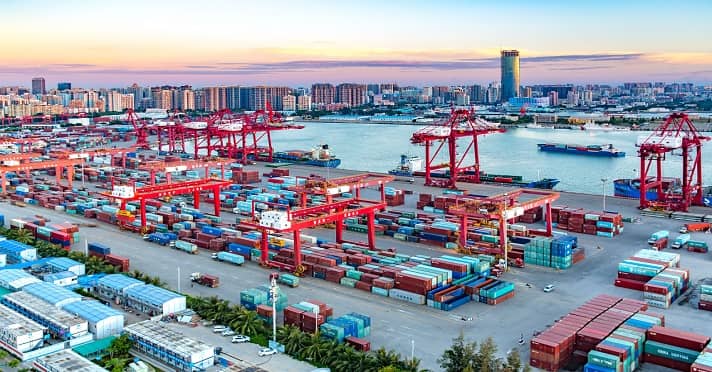The construction of China’s Hainan Free Trade Port has official gone underway. With high expectations, the government anticipates that it will be the center of commerce in China once the first phase has come to a conclusion, by 2025. In this article we look to provide insight on the Hainan Free Trade Port, the key policies in the region and how exactly it will work.
What is the Hainan Free Trade Port?
The Hainan Free Trade Port (FTP) is part of the government’s effort to make Hainan an influential global trade port for the benefit of expanding the Chinese market. The Hainan FTP is run by the Chinese government under a socialist system. It will be established in 34,000 square kilometers of land, which will make it the largest of its kind in the world.
In June 2021, the Hainan Free Trade Port Law of PRC took effect a year after China announced its major plans for Hainan. The goal is to implement a series of policies that will transform Hainan into a world-class free-trade hub similar to that of Singapore and Hong Kong.
The greatest advantage that the Hainan FTP will offer is the exemption of goods usually prohibited from being imported or exported. Other overseas merchandise will also be allowed free trade after 2025.
Goods exported overseas from the Hainan FTP will still be subject to export and tax regulations. However, merchandise not on the import taxation list can be imported tariff-free. Goods entering the Hainan FTP from mainland China will also be handled according to domestic regulations.
The Hainan Free Trade Zone
The Chinese government looks forward to making Hainan a key destination for commerce, diverting shoppers and business players away from other major ports like Hong Kong.
Foreign investors can invest in Chinese private equity products, along with being able to transfer capital into and out of the country, as long as it is within the provided limits. Similarly, companies residing in the Hainan FTZ can raise or borrow capital with a higher cap from foreign banks.
Previously, China had been preventing capital flight by imposing strict trade rules. Currently, the government has shifted its priorities to promote the yuan as an international currency by allowing domestic funds to be invested in foreign equities of up to USD 5 billion.
Hainan FTZ will also be a testing ground for innovative real estate policies. The finance ministry has been considering enforcing property taxes to stabilize market prices, and Hainan will be a good candidate for an initial testing phase of the policy. If deemed successful, programs implemented in the Hainan FTZ will be brought to mainland China.
The Difference Between an FTP and FTZ
A free-trade port (FTP) refers to a port area outside the jurisdiction of customs checkpoints but still resides within a country’s boundaries. This kind of setup enables the free entry and exit of merchandise. On the other hand, a free-trade zone (FTZ) is situated within the mainland and is within the administration of customs checkpoints.
China established the Shanghai FTZ (read more about the Shanghai Free Trade Zone) to test how market reforms will have an effect on certain industries. It aims to improve the overall business environment by providing a one-stop solution for all businesses in the zone. The setup is expected to support China’s Belt and Road Initiative (BRI) and open the Chinese market to bilateral free trade agreements with other countries.
FTPs are opened to strategically stimulate economic development. According to a study, there are more than 2,000 FTPs worldwide, with China as one of the major countries running them.
Key Elements of the FTP in Hainan
Liberalization and the Facilitation of Trade
A special customs supervision zone system will be established in the area. It will help Hainan FTP become the forerunner for overseas trade, while being the ‘second line’ to trade with the mainland.
Hainan FTP will be opened to freely importing and exporting goods with other countries, so long as the merchandise is not on the prohibited or restricted list. Goods entering mainland China from Hainan FTP will be more tightly controlled.
Liberalization and Facilitation of Investment
The negative list for foreign investments will be simplified to allow for a more accessible Chinese market. In December of 2021, the Hainan FTP authorities released a new negative list that permits expanded market access to foreign investment in sectors previously restricted like education, telecommunications, manufacturing, mining, and business services.
Fiscal and Taxation Systems
The Hainan FTP will launch a simplified taxation system, including a zero-tariff advantage for certain goods by 2025.
Policies for lower tax rates will also be enforced over corporate income tax (CIT) and individual income tax (IIT). Under this system, businesses in Hainan that have engaged in substantial activities in specific industry sectors will pay a lower CIT rate of 15% by 2025. This deduction almost halves corporate taxes from the general 25% rate that’s applied.
High-end and in-demand talents working in the Hainan FTP may enjoy additional tax exemptions, so long as they satisfy certain criteria. A portion of their actual IIT that exceeds 15% will be exempted from tax collection by 2025.
The reduced tax rates do not imply that Hainan FTP is a tax haven. For enterprises to obtain preferential tax treatments, substantial economic activity in the area should be established first.
Environmental Protection Policies in Hainan
The Hainan FTP will be protected by laws for ensuring strict ecological and environmental protection.
Industrial Development and Talent Support
Hainan FTP will be transformed into an international tourism center that will emphasize culture, sports, retirement, and medical care. Aside from attracting strong local talents, the region will also target expatriates and international students.
Advantages of the Hainan FTP
- Increased investment – Foreign investors will have greater access and opportunity to invest in numerous key sectors not usually available to them including telecommunications, tourism, and education.
- Removal of investment caps – Foreign investment caps will be lifted in certain areas like international maritime transport, breeding of new vegetable varieties, and seed production of new variants.
- Increased autonomy – More autonomy in granting access to foreign investments, including the establishment of universities and vocational colleges.
- More efficient procedures – Improved customs efficiency for more streamlined processing of transactions.
- Access to foreign medical supplies – Medical patients can get medicine and medical equipment from the EU, Japan, and the US even before they have been accredited by the Chinese government.
- Reduced tax rates – Lower tax rates for businesses and individuals that will operate or reside in the area.
Tax Regime in the Hainan Free Trade Port
China aims to make the FTP in Hainan a major global free trade port by 2050. To do this, the government plans to roll out a series of changes in the tax and legal systems. A key long-term objective is for the area to offer zero tariffs, a simplified taxation system, low tax rates, and a well-developed legal system.
First, the zero-tariff policy will be rolled out in two stages and will be in full effect by 2025. During the first stage, only a few import categories will be given zero-tariff treatment to spur the development of the tourism, e-commerce, and logistics sectors in the area.
During the second phase, which is set to be launched after 2025, the tariff policy will be expanded to cover a wider range of import categories.
What makes Hainan FTP special compared to other special supervision zones in the country is primarily the unique import processing regulations. Goods can be imported and processed in Hainan, and then sold in China at zero tariffs. This allows local businesses to optimize their supply chain and lower the overall production cost of goods.
The main requirement in the Hainan FTP is that the processing should meet the 30% value-added threshold. Additionally, goods should have the label ‘Hainan Origin Certificate.’
Business Outlook for the FTP
Usually, FTPs rely first on re-export trade before gradually moving to integrated services. Hainan FTP will be different as it will place focus on tourism, high-tech industries, and modern services without forgetting about trading goods.
China aims to recover local demand for services usually found by Chinese residents overseas. An example of this is the medical tourism market that has been tapped promoted by foreign countries, like Japan and the Middle East. To initiate the plan, China is developing a 20 square kilometer medical tourism zone in Bo’ao that will house 16 medical facilities. The medical centers will offer rehabilitation and cosmetic services among others.
Final Thoughts
The Chinese government is making a concerted effort to develop Hainan Island into one of the leading global trade ports. With greater autonomy, encouraging a more open market, there are high ambitions for the FTP in Hainan to compete with that of Singapore and Hong Kong. With its attractive tax policies and regulations that promote commerce, many enterprises are looking to set up in the region and capitalize on the benefits from an early stage.
As MSA, we are dedicated to delivering high quality accounting, financial advisory and business setup services to our clients. After being in operation in China for more than a decade, we have extensive knowledge on doing business across all regions and provinces. Get in touch with us today and our consultants can provide you with the understanding you need to drive your enterprise towards success.





